

Like the other allied cities of Umbria, Asisium became a municipium after the Social Wars (ca. 90 BC) and was administered by quattuorviri. It was the only municipium in Umbria to be assigned to the Sergia tribe.
Urban Development: Piazza del Comune
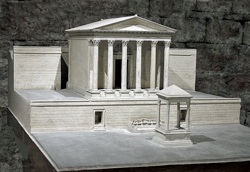
Reconstruction of the so-called Temple of Minerva (Museo Civico)
The French archaeologist Charles Victor Famin carried out the first excavations of what is now Piazza del Comune in 1836, when he discovered the original pavement some 5 metres below the current one. This excavated area con now be visited from Museo Civico. Epigraphic evidence, discussed below, suggests that:
-
✴the walls of the terrace that subsequently supported to so-called Temple of Minerva were built and the space below them (now Piazza del Comune) was paved in the period 90-40 BC;
-
✴the temple itself and (probably) the tribune immediately below it were all built after the Perusine War (discussed below); and
-
✴and the tetrastyle further in front of it was built in the period 14-68 AD (see below).
Lower Terrace Wall
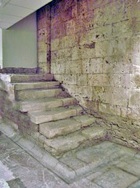
The holes at regular intervals in the upper part of the terrace wall between these two entrances were originally used to fix a bronze decorative frieze of garlands in place. The retaining wall continues beyond the temple, although the style of its construction changes: the stone blocks in this less prestigious location become smaller and less regular. This part of the wall was probably used for the display of laws and decrees promulgated by the government of the municipium.
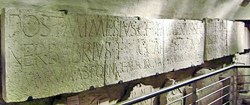
The long inscription (CIL XI 8021, 89-40 BC), which is now displayed in front of this wall, originally referred to the men responsible for the building or restoration of this terrace wall:
-
✴the two quattuorviri iure dicundo, whose names have been lost; and
-
✴the quinqueviri (a magistracy that is discussed in the following page):
-
•C(aius) Babrius Chilo, son of C(aius);
-
•C(aius) Veistinius Capito, son of C(aius);
-
•C(aius) Vallius, son of C(aius);
-
•L(ucius) Visellius, son of L(ucius); and
-
•Cn(aeus) Veistinius, son of Cn(aeus); and
-
✴C(aius) Attius Clarus, son of T(itus), who paid for the stucco decoration of the wall.
Paving of the Space in Front of the Terrace Wall
The tribune immediately in front of the terrace wall and the tetrastyle further in front of it each obscures some of the holes in its pavement that were left by the bronze letters of an inscription (AE 1981, 0317, 89-40 BC). The holes that remain unobscured are found on 13 marble blocks (illustrated in the EAGLE database - see the AE link) that are perfectly aligned with the axis of the later temple. Although these blocks were discovered in 1839, a transcription of the corresponding part of the inscription was only published in 1981. It records:
-
✴the quattuorviri iure dicundo:
-
•C(aius) Caetronius [?]ar(ius?), son of C(aius); and
-
•C(aius) Attius Ruf(ius), son of C(aius); and
-
✴two other men whose magistracy was probably recorded on the stones now under the tetrastyle:
-
•T(itus) Olius Gargenna, son of C(aius); and
-
•L(ucius) Ca[..]tius B....., son of C(aius).
Scholars generally assume that these last two men were quinqueviri (discussed on the following page): thus Enrico Zuddas (referenced below, at p. 238) suggested that:
-
“... the names of another three men [i.e. the other three quinqueviri] and a final formula of the type ‘senatus consulto faciundum coiravere’ were [probably] obliterated by the tetrastyle that was built above” (my translation).
Enrico Zuddas (referenced below, at p. 357, entry 13B) described another block that was found in 1969 near the steps to the left that led up to the pronaus of the temple, with evidence of an inscription that can be restored as:
[... ]ca Cn(aeus) Fuficius [....]
As discussed in the following page, this block might have been the 14th of the series above, and Cn(aeus) Fuficius [....] might be the name of the third quinquevir.
Perusine War (40 BC)
The triumvir Octavian established an important colony at Hispellum for the the veterans of the civil wars that had finally begun to subside in 41 BC. Many local landowners suffered what were probably illegal confiscation, and this precipitated a major revolt during which the Consul Lucius Antoninus, who sympathised with the rebels, was besieged by Octavian at Perusia. As Cassius Dion summarised:
-
“The investment [of Perusia] proved a long operation; for the place is naturally a strong one and had been amply stocked with provisions; and horsemen sent by Lucius before he was entirely hemmed-in greatly harassed the besieger, while many others besides came speedily to his defence from various quarters. Many attacks were made upon these reinforcements separately and many engagements were fought close to the walls, until the followers of Lucius, even though they were generally successful, nevertheless were forced by hunger to capitulate.” (‘Roman History’, 48: 14: 2-3).
The family of the poet Propertius was famously caught up in these tragic events.
Propertius
The poet Sextus Propertius, who was born in ca. 50 BC, began to publish his work in Rome in 25 BC and died about ten years later. What is known about his life comes almost entirely from his own poems. However, one fortunate exception is provided by a letter written by Pliny the Younger (VI: 15, to Romanus), in which he (Pliny) described a later poet who claimed Propertius as an ancestor:
-
“Passennus Paullus, a Roman knight of good family, and a man of peculiar learning and culture besides, composes elegies, a talent which runs in the family, for Propertius is reckoned by him amongst his ancestors, as well as being his countryman.”
A surviving funerary inscription (CIL XI 5405) in the Museo Civico, which commemorates Gaius Passennus Sergius Paullus Propertius Blaesus, came from an ancient cemetery in Assisi, so the last phrase in the extract above (‘municeps Properti atque’ in the original Latin) suggests that the more famous Propertius also came from Assisi. This is apparently confirmed by Propertius himself in the first elegy of Book 4:
-
“Ancient Umbria ... bore you [Propertius] ... Where misty Mevania wets its hollow field and lake Umber warms the summer waters, the rampart of towering Asisium - made more famous by your genius - surges from [the hilltop]” (Elegy 4:1, adapted from the translation by Vincent Katz, referenced below, at pp. 343-5).
This elegy continues with an account of the troubles that faced the young Propertius:
-
“You [Propertius] gathered bones that should not have been gathered so young - your father’s bones - and were yourself forced into modest quarters: for when countless bulls were [still] ploughing your fields, the dull measuring-rod [of the Roman land surveyors] took away [your] wealth” (Elegy 4:1, adapted from the translation by Vincent Katz, referenced below, at p. 345).
The confiscations suffered by the family of Propertius were presumably associated with the deduction of the colony at nearby Hispellum, for which there is epigraphic evidence in the late 1st century BC. Two consecutive elegies in Book 1 also refer to the suffering of the Propertii, presumably at about this time:
-
✴In the first of these, the ghost of a dead soldier called Gallus addresses a fellow soldier who has been wounded during a battle in Etruria:
-
“You scramble to avoid my fate, soldier, wounded at the Etruscan rampart. Why do you roll swollen eyes when I groan? I am from the next [army] unit. I hope you make it [home alive ... If you do], let my sister Acca know ... that Gallus, [who was] snatched from the midst of [Octavian’s] swords, tried to escape unknown hands but was not able. No matter how many bones she may see scattered on the Etruscan mountains, let her know that these are mine” (Elegy 1:21, adapted from the translation by Vincent Katz, referenced below, at p. 75).
-
✴In the second, Propertius answers question put to him by his friend Tullus:
-
“What class I am and from where, and who [are] my Penates [house gods]?: you ask all of this, Tullus, in the name of our long friendship. If the Perusine tombs of our country are known to you - [memorials of] Italy’s hard times, when Roman discord hunted her citizens - this was especially painful for me: [that] my Etruscan soil allowed my kinsman’s limbs to be abandoned, ... the poor man’s bones were covered with no earth. Umbria, below Perusia, bore me ... ” (Elegy 1:22, adapted from the translation by Vincent Katz, referenced below, at p. 77).
The relationship between:
-
-the unburied Gallus and the wounded soldier in the first of these elegies;
-
-the unburied kinsman of Propertius in the second; and
-
-Propertius’ father;
is unknown and (despite the best efforts of a number of scholars) probably unknowable. However, the elegies in Book I clearly place the first three as casualties of the Perusine War (41-40 BC), when Octavian laid siege to Perusia, which sheltered the rebel Lucius Antonius. As Laurence Keppie (referenced below, at p. 178) observed:
-
“The Propertii of Asisium, recently deprived of the of a substantial part of their property (or under threat of deprivation) are easily envisaged as supporters of Lucius Antonius, rallying to his aid at nearby Perusia .”
As we shall see below, despite these setbacks, the family survived and indeed prospered at Perusia in the early imperial period.
Elegy 4:1, part of which is quoted above, continued with Propertius account of his coming of age:
-
“Soon, when the golden amulet was removed from your virgin neck [Propertius], and you assumed the the toga libera before your mother's gods, then Apollo... forbade you to shout insane poetry in the forum: [instead, he insisted that you should write] elegies ...” (adapted from the translation by Vincent Katz, referenced below, at p. 345).
Giorgio Bonamente (referenced below, at p. 33) suggested that this passage described the moment in ca. 30 BC at which Propertius completed his education, shortly before he moved to Rome. It seems that his mother had overseen his education, perhaps in preparation for a career at the bar (which would have involved insane poetry shouted in the forum), but that he had instead decided to become a poet. Once in Rome, like Horace and Virgil, he prospered in this profession under the patronage of Octavian’s friend and advisor, Gaius Maecenas.
So-called Temple of Minerva
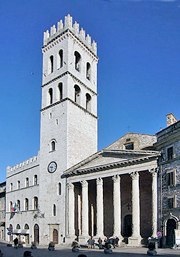
The holes that held bronze lettering across the architrave of the temple have made it possible to deduce the content of an inscription (CIL XI 5378) that recorded the names of the brothers who built it, both of whom were quattuorviri quniquennales (i.e. two of the four magistrates charged with carrying out the five-yearly census):
-
✴Cn(aeus) Caesius Tiro; and
-
✴T(itus) Caesius Priscus, the sons of Cn(aeus).
The EAGLE database (see the CIL link above) dates the inscription to the period 40-20 BC. Filippo Coarelli (referenced below, at p. 21) pointed out that:
-
“The name ‘Caesius’ seems to have been unknown at Asisium before this time, which suggests that we are dealing with beneficiaries of the confiscations that afflicted the city in the triumviral period, which constituted one of the principal causes of the Perusine War [of 41-40 BC]” (my translation).
The temple seems to have been modelled on the Temple of Divus Julius (42-29 BC), which Octavian (soon to become the Emperor Augustus) built in the forum of Rome in honour of the deified Julius Caesar. The Caesii brothers probably adopted this design as a means of ingratiating themselves with Augustus.
The original Corinthian columns of the front of the pronaus survive. Two further columns on each side, which are visible in Andrea Palladio’s drawing (ca. 1538), which he later published in "I Quattro Libri dell Architettura", have been destroyed, along with the original paving and coffered ceiling. The lateral walls of the cella of the temple survive, although they are not visible from the interior. (The left wall can be seen from the inner courtyard of the Convento di Sant Antonio at number 2 Via San Paolo, which is sometimes open for exhibitions). The back wall was demolished in 1634.
Early Empire
Despite the confiscations at the time of the Perusine War, there is no evidence of any interruption of its growing prosperity. Indeed, the assimilation of new settlers such as the Caesii brothers (above) probably boosted the economy. The plethora of later inscriptions (only a few of which are described here) point to a vibrant society from at least this time. However, there were perceptible changes in in individual fortunes: for example, Francis Cairns (referenced below, at p. 13) identified three social trajectories:
-
✴of local families:
-
•the Propertii and the Mimisii emerge as prominent survivors; while
-
•other leading families such as the Babrii and Voisieni, who feature in the inscriptions from the period before the war (above), declined or disappeared thereafter, and
-
✴other families such as the Caesii (above) and the Petronii, who had not apparently featured in the civic life of Asisium before the war, now came to prominence.
Cairns (at p. 14, note 68) suggested that not only the Caesii but also the Petronii had been beneficiaries of the confiscations after the Perusine War.
Gens Propertia
Cnaeus Propertius Scaevae
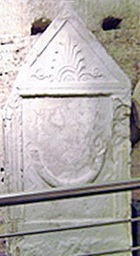
Gaius Passennus Sergius Paullus Propertius Blaesus

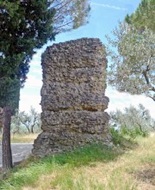
CIL XI 5405 Mausoleum (1st century AD)
next to the Chiesetta di San Feliciano
This inscription (CIL XI 5405) on the front of a funerary altar was found in 1897 near the Chiesetta di San Feliciano (see Walk II). The inscription commemorates Gaius Passennus Sergius Paullus Propertius Blaesus, who probably belonged to the gens Passenna by adoption. He was described in two of the letters of Pliny the Younger (VI: 15, to Romanus and IX: 22: to Severus) as a poet in his own right and a descendant of the more famous poet Propertius. None of his poetry survives. The EAGLE database (see the CIL link) dates the inscription to the first two decades of the 2nd century AD.
Blaesus was probably the owner of the so-called House of Propertius. Francs Cairns (referenced below, at pp. 52-3) suggested that he had been buried in the mausoleum (1st century AD) to the right of the Chiesetta di San Feliciano (illustrated above).
Other Funerary Inscriptions from San Feliciano
Two other funerary inscriptions of the Propertii from the 2nd century AD have been found nearby:
-
✴CIL XI 5520, which commemorated Titus Propertius Gratus son of Titus (now in the Museo Civico)
-
✴CIL XI 5406a, which is known only from an unreliable transcription that suggests that two members of the gens Petronia erected a funerary monument for a Caius Propertius Cliso.
Sextus Caesius Propertianus
An inscription (CIL XI 5028) on the base of a statue of him, which came from an unknown location in Bevagna (now in the Museo della Città there ), reads:
SEX(TO) CAESIO SEX(TI) [F(ILIO)] / PROPERTIANO
FLAMINI CERIALI
ROMAE PROC(URATORI) IMP(ERATORIS)
A PATRIM(ONIO) ET HEREDIT(ATIBUS)
ET A LI[B]ELL(IS) TR(IBUNO) MIL(ITUM) LEG(IONIS) IIII
MACEDONIC(AE) PRAEF(ECTO) COH(ORTIS)
III HIS[PA]NOR(UM) HAST(A) PURA
ET CORON(A) AUREA DON(ATO)
IIIIVIR(O) I(URE) D(ICUNDO) IIIIVIR(O) QUINQ(UENNALI) PON(TIFICI)
PATRON(O) MUN(ICIPII)
Thus, as Maria Carla Spadoni (referenced below, 2010, at p. 122) pointed out:
-
“Through the network of adoptions, an exponent of the gens Propertii [of Asisium] ... , Sextus Caesius Propertianus, became a magistrate and patron of Mevania in the Flavian period [as evidenced by CIL XI 5028]” (my translation).
However, François Chausson (referenced below, at p. 118, note 70) noted that:
-
“It is not necessary to believe that the [additional cognomen] Propertianus must indicate an adoption, his mother could have been a Propertia, [in which case, the form of his name] would indicate indicate an alliance between two families belonging to the Umbrian élite” (my translation).
This inscription also records that Sextus Caesius Propertianus held a number of important posts earlier in his career, which included: Flamen Cerialis (a priest assigned to the goddess Ceres); procurator of the private fortune of an emperor; Military Tribune of the Fourth Macedonian Legion; and Prefect of the Third Spanish Cohort. He was also the winner of two high military medals: the Hasta Pura (literally “arrow without a head”); and Corona Aurea (Golden Crown). The Fourth Macedonian Legion was disbanded in 70 AD: Valerie Maxfield (referenced below, at p. 112) suggested that:
-
“[Propertianus’] military service ought to belong to the civil war period, and the decorations to have been awarded by Vitellius - an observation that ties neatly with the fact that no reference is made to the campaign to which the decorations belong nor to the emperor who awarded them.”
Propertianus presumably held his posts of quattuorvir iure dicundo, quattuorvir quìnquennali and pontifex at Mevania thereafter. The EAGLE database (see the CIL link above) dates the inscription to some time during the last three decades of the 1st century
Gens Mimisia
As noted above, an inscription (CIL XI 5390) over an arch that leads to a Roman cistern that now forms the foundation for the campanile of San Rufino records three pairs of marones (magistrates) as a dating device in a record of a public project carried out in the late 2nd century BC: they presumably held office in pairs in the three years over which the work was carried out. The first of these pairs was:
-
✴Post(umus) Mimisius, son of C(aius);
-
✴T(itus) Mimisius, son of Sert(orius).
A number of other inscriptions from Assisi record this family in the period after the Perusine War. One of the most interesting of these is CIL XI 5495, on a funerary altar from Capodacqua (now in the Museo Civico,) which the EAGLE database (see the CIL link) dates to the 2nd half of the 1st century AD. It commemorates a freedwoman, Mimisia Restituta, who had been freed by two Mimisii, Primigenius and Servandus (who were probably brothers), and who had married one of them.
Inscriptions at Hispellum
Two inscriptions from Hispellum record members of the gens Mimisia at Hispellum:
-
✴A funerary inscription (CIL XI 5278) from an unknown location that is now embedded in the façade of the church of San Lorenzo in Spello, which the EAGLE database (see the CIL link) dates to the Augustan period (27BC - 14 AD), commemorates:
-
•Caius Alfius Rufus, son of Caius and member of the Lemonia tribe, who was duovir quinquennalis of the Colonia lulia Hispellum after having held that post in his native Casinum;
-
•Caius Alfius Quadratus, son of Caius and member of the Lemonia tribe, who was a sevir a knight and, at the time of his death, an aedile;
-
•Alfia, daughter of Caius, who was probably the sister of Alfius Rufus and Alfius Quadratus; and
-
•Mimisia, who was the wife of one of the brothers.
-
Mimisia had clearly married into the gens Alfia, a family that had moved to Hispellum from Casinum in northern Campania after colonisation and who had achieved a prominent position there.
-
✴An inscription (CIL XI 8011) in Palazzo Bianconi at Spello, which was found in the road in front of San Lorenzo there and which the EAGLE database (see the CIL link) dates to the early 1st century AD, records that Caius Mimisius had financed the construction of a portico.
Postumus Mimisius Sardus
Postumus Mimisius Sardus is commemorated in an inscription (CIL XIV 3598) from Tivoli (now in the Musei Vaticanii and illustrated in this website), which the EAGLE database dates to the period 14 - 50 AD. He was probably the first man from Assisi to enter the Senate, probably during the reign of Tiberius.
Gens Petronia
Publius Petronius, son of Caius
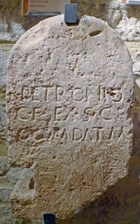
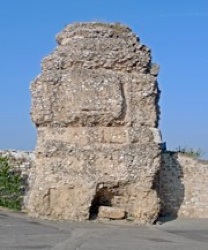
CIL XI 5407 Mausoleum ( early 1st century AD)
near Piazza Matteotti
This inscription (CIL XI 5407) was found at an unknown location in Assisi that was recorded in the original CIL as the ‘asilo infantile’ (an orphanage, probably the one in Piazza Matteotti that late became the Convitto Nazionale di Assisi). The inscription, which is in the Museo Civico (exhibit 31), reads:
P(ublius) Petronio
C(ai) f(ilio) ex s(enatus) c(onsulto)
(l)ocum dat(u)m
This records that the municipal senate gave a site to Publius Petronius, son of Caius. The EAGLE database (see this CIL link) dates it to the 2nd half of the 1st century BC.
It is possible that this inscription related to the mausoleum (early 1st century AD) near Piazza Matteotti, although it seems to me that its dating precludes that. However, it is possible that the senate gave a site here to Publius Petronius for funerary purposes, and that CIL XI 5407 was his funerary monument. On this hypothesis, the mausoleum could have been built subsequently on this site for use by other members of the family. (For possibly supporting evidence, see Petronius Umber below). As Enrico Sciamanna (referenced below, at p. 142) reflected, if the person buried in the mausoleum did not belong to the gens Petronia, he:
-
“... must have belonged to an important family, on a par with or superior to that of the Petronii” (my translation).
? Petronius, Quattuorvir Iure Dicundo

Petronia, Wife of Galeo
A now-lost inscription (CIL XI 5511) from an unknown location in Assisi read:
[Pet]ronia/ C(ai) f(ilia)/ [G]aleonis 〈:uxor〉
[test]amento/ [arbitr]atu Suria=/ [- - - - - -]
Gian Luca Gregori (referenced below, at p. 972) suggested that Galeo came from the family of the Tettieni, the only family in Assisi known to have used the praenomen Galeo (see below). The EAGLE database (see this CIL link) dates it to the period 27BC - 50 AD.
Inscription Relating to the Amphitheatre
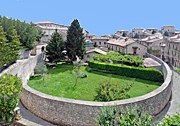
Remains of the amphitheatre of Asisium (early 1st century AD)
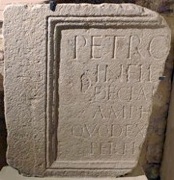

CIL XI 5406 CIL XI 5432
Two surviving fragmentary inscriptions that relate to the amphitheatre were found in Piazza Matteotti and are now in the Museo Civico:
-
✴A fragmentary inscription (CIL XI 5406) reads:
-
Petro .../ in fid.../ Decia.../ amphi.../ quod ex .../ perfic ...
-
✴A second fragmentary inscription (CIL XI 5432) reads:
-
[- - -]s municipi(- - -?)/ [- - - f]ratr(is) nomin(e)/ [- - - amphitea]tri ornam(ent-)
The EAGLE database (see the CIL links above) dates them to the 1st half of the 1st century AD. It reconstructs the first as inscription as:
Petro[nia C(ai) f(ilia) Galeonis 〈:uxor〉]
in fid[eicommisso solvendo?]
Decian[i fratris nomine, ((sestertium)) - - - dedit in opus?]
amph[itheatri cum ornamentis?]
quod ex [testamento ex ((sestertium)) - - - fieri iussit?]
perfic[iendum curavit - - -].
The EAGLE reconstruction of the second suggests that this contained broadly the same information. In short, the original inscriptions probably recorded that Petronia, wife of Galeo, completed the construction and/or decoration of the amphitheatre as the executor of her brother, Caius Petronius Decianus. Gian Luca Gregori (referenced below, at p. 979) dated the construction of the amphitheatre to the 1st half of the 1st century AD.
Galeo Tettienus Paradalas
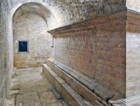
-
✴Galeo Tettienus Pardalas; and
-
✴his wife (or mother) Tettiena Galene;
and says that they distributed money at the dedicatory festival:
-
✴5 denari to each decurione;
-
✴3 denari to each of the seviri (the members of a college of six magistrates or priests); and
-
✴a denarius to each of the plebs.
The EAGLE database (see the CIL link above) dates the inscription to the period 14-68 AD. Gian Luca Gregori (referenced below, at p. 972) suggested that Galeo Tettienus Pardalas and his wife were freed slaves of Galeo Tettienus, the husband of Petronia (see above).
Galeo Tettienus Petronianus
An inscription (CIL XVI 0021) records that Galeo Tettienus Petronianus and held the consulate with Marcus Fulvius Gillo on 2nd December 76 AD, as suffects for the Emperor Vespasian and his son, the Caesar Titus. Gian Luca Gregori (referenced below, at p. 972) suggested that he was the son of Galeo Tettienus and Petronia (see above).
Petronius Umber
A fragmentary inscription (CIL XI 5409) in the Museo Civico (exhibit 32), which is from an unknown location in Assisi, reads only ‘SEPV’. However, an 18th century record of what was probably the original inscription gives:
Petronio Umbro in loco publico sepulto ex decreto decurionum
Thus, Petronius Umber received received permission for burial on public land some 3 centuries after a similar honour had been paid to Publius Petronius (above). It is possible that this land was around the site of the mausoleum near Piazza Matteotti.
Read more:
M. C. Spadoni, “Perugia Romana 4: L'età di Ottaviano Augusto”, Bollettino della Deputazione di Storia Patria per l'Umbria, 107 (2010) 5-56
E. Sciamanna, “Asisium: Percorsi Archeologici nel più Importante Municipio Romano a Nord di Roma”, (2008) Assisi
F. Cairns, “Sextus Propertius: The Augustan Elegist”, (2006) Cambridge
G. Asdurabli Pentiti, entry 22, in:
M. Matteini Chiari (Ed.), "Raccolte Comunale di Assisi", Milan (2005)
G. Bonamente, “Properzio, un Esponente dell' Aristocrazia Municipale di Asisium nella Roma di Augusto”, in
C. Santini and F. Santucci (Eds.), “Properzio tra Storia, Arte, Mito: Atti del Convegno Internazionale, Assisi, 24-6 Maggio 2002”, (2004) Assisi, pp. 17-74
V. Katz, “The Complete Elegies of Sextus Propertius” (2004) Princeton
F. Chausson, “Note sur Trois Clodii Sénatoriaux de la Seconde Moitié du IIIe Siècle”, Cahiers du Centre Gustave Glotz, 9:1 (1998) 177-213
F. Coarelli, "Assisi Repubblicana: Riflessioni su un Caso di Autoromanizzazione", Atti Accademia Properziana del Subasio, (1991) Assisi
G. L. Gregori, “Amphitheatralia I”, Mélanges de l' École Française de Rome, 96 (1984) 961-85
L. Keppie, “Colonisation and Veteran Settlement in Italy, 47–14 BC”, (1983) Rome
V. Maxfield, “The Military Decorations of the Roman Army”, (1981)Berkeley and Los Angeles
Ancient History: Main Page Municipium of Asisium Quinqueviri and Seviri
Return to the home page on History
Return to the home page on Assisi

